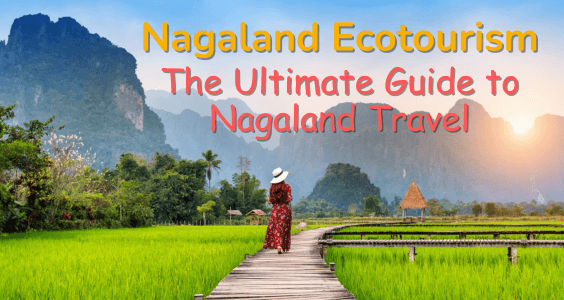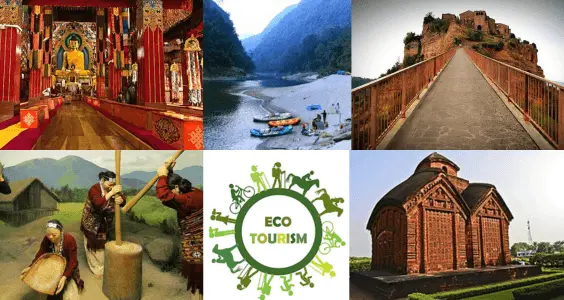
Introduction to Nagaland ecotourism and its growing significance
So don’t just travel and take pictures, but live the moment and explore new places, learn more about the places and share your experience about what you learned during the trip.
Hello readers and explorers, so what have you heard about Nagaland? And did you know that there are two sides to learning about a new place? First of all are the local people who lived their lives at that place. And secondly Perspective, a new way of looking at things.
This post will provide information about Nagaland Ecotourism, the undiscovered gem of Northeast India and the amazing natural beauty of Nagaland combined with rich cultural heritage to create a unique experience.
With the development of ecotourism, Nagaland has become a popular destination for tourists looking for intensive and sustainable travel experiences. You can learn all about ecotourism in this fascinating region by reading our comprehensive guide to Nagaland travel and ecotourism.
Understanding Ecotourism in Nagaland
What is ecotourism and what are the main concepts of ecotourism in India?
Generally, ecotourism refers to a responsible and sustainable form of travel that emphasizes conservation of the environment and human well-being for local communities. In addition to promoting understanding and respect for the local population and the natural and cultural heritage of the destination, it aims to reduce the negative impacts of tourism on the environment. Unlike traditional tourism, which often leads to environmental degradation and cultural insensitivity, ecotourism aims to create a symbiotic relationship between tourists, nature and the local population.
Main Concepts of Ecotourism
Sustainability: It is our responsibility to save nature, sustainability is a basic component of ecotourism and to spread awareness among others. This includes taking steps to protect the environment, guarantee resource sustainability, and minimize the harmful effects of tourism on regional ecosystems.
Conservation: Ecotourism helps in saving the natural environment and wildlife and preserving these things for the coming generations is one of our major duties. This often includes activities such as wildlife observation, environmental hikes, and conservation projects that help save endangered species and fragile ecosystems.
Education and Awareness: Providing tourists with information about the local lifestyle and environment is an important component of ecotourism and this is where Witan India’s local guide will help you navigate in an easier way. This includes giving details about local fauna, conservation initiatives and the cultural value of the area.
Community Involvement: We are all human beings and ecotourism emphasizes the participation of the surrounding local communities in the organization and administration of tourism-related activities. Its objective is to provide financial benefits and job opportunities to the local people so that tourism can sustain their lives.
Cultural Respect: Since we also belong to certain communities, ecotourism requires a high level of respect for the customs and cultures of the area. Visitors are encouraged to interact with and learn from local communities in a way that respects and preserves their way of life.
Low Impact: Activities related to ecotourism are designed keeping in mind minimal environmental impact. This includes booking eco-friendly accommodation, cutting down on waste and controlling how many people visit sensitive places.
Ecotourism in India
Ecotourism in India is a completely new approach in the field of tourism. Ecotourism holidays involve visiting natural areas of India and observing the culture and natural history of the place, while also taking care that the ecosystem is not disrupted in any way. Ecotourism creates economic opportunities that make conservation and protection of natural resources beneficial to the local people of India.
With India’s rich biodiversity and diverse cultural heritage, it offers many opportunities for ecotourism. Some of the major concepts and practices of ecotourism in India are as follows:
Wildlife Sanctuaries and National Parks: Ranthambore National Park, Kaziranga National Park, Jim Corbett National Park and other national parks and wildlife sanctuaries are located in India. These areas are essential for the survival of endangered animals such as tigers, rhinos and elephants. Responsible animal observation and conservation activities are the main goals of ecotourism in these parks.
Community-Based Tourism: Community-based tourism initiatives have been developed in places like Kerala, Rajasthan and the North-East to involve local communities in tourism activities. Through these initiatives, economic benefits are provided to local people, and tourists can experience the cultural and natural richness of these areas.
Eco-Friendly Accommodations: The popularity of eco-lodges and eco-resorts is increasing in India. These residences use sustainable methods including solar power, rainwater harvesting and waste recycling. Spice Village in Thekkady, Kerala and Banjar Tola in Kanha, Madhya Pradesh are two examples of this.
Adventure and Nature Activities: River rafting, camping, bird watching, trekking and other eco-friendly adventure activities are available in North East India. The Western Ghats, Andaman and Nicobar Islands and the Himalayas are popular destinations for this type of travel.
Conservation Projects: Conservation of endangered species and their habitats is the main goal of many NGOs and conservation initiatives in India. Travelers can assist in several conservation initiatives, such as the Ladakh Snow Leopard Conservation Project or the Odisha Olive Ridley Turtle Conservation Project.
Cultural Heritage: In India, ecotourism also includes conservation of cultural heritage. This includes visiting historic villages, participating in regional festivals, and working in traditional artisan studios. It encourages respect and knowledge of India’s many cultural environments.
Rural Tourism in Nagaland
In Nagaland, rural tourism offers a chance to witness traditional Naga life in person. It is possible for guests to stay in nearby villages, participate in customs and learn more about the lifestyle and culture of the area. Nagaland has 1,317 officially recognized villages, of which 1,278 villages are home to 16 different tribes.
Each tribe has its own traditions, languages and clothing. It is a land of festivals, where each tribe celebrates its own festival during certain months of the year. Except for a small area of terraced cultivation in the foothills, much of the state’s geography is hilly, and shifting cultivation is the predominant agricultural practice. The highland forests of the state are home to a variety of rich flora and animals.
Importance of Ecotourism in Nagaland
Nagaland is a top choice for ecotourism due to its unique biodiversity and ethnic cultures. Travelers can contribute to the preservation of the area’s natural resources and cultural history by supporting sustainable activities. This strategy also supports local towns economically, which also benefits the environment and the local population.
Challenges of tourism in Nagaland
The development of Nagaland’s tourism industry will not be easy. This state in northeastern India, famous for its colorful tribal culture and stunning scenery, has many hurdles to overcome.
Lack of infrastructure: The state does not have adequate transit, housing and road systems. Travel is challenging for tourists due to poor connectivity and inadequate facilities.
Political Instability: Due to political instability, potential tourists have started moving away from Nagaland due to political turmoil and insurgency issues. Tourism is adversely affected by security concerns and sporadic travel advisories.
Inadequate awareness and promotion: Nagaland’s appeal as a travel destination has not been well marketed or promoted. The state’s unique attractions and cultural heritage are not well known to outsiders.
Restricted areas: Visitors face administrative hurdles when entering certain parts of Nagaland, which require special licenses. This restriction may prevent travelers from visiting scenic spots in the state.
Environmental Issues: Unplanned travel can harm the environment. It is difficult to ensure sustainable tourism practices while highlighting the natural beauty of the state.
Cultural Sensitivity: Each of the many tribal communities in Nagaland has its own traditions and customs. It is essential to guarantee that tourism does not cause disruption or disregard for these traditional customs.
Limited Skilled Manpower: The travel and hospitality industry is facing a shortage of qualified workers. This affects how well service is provided to tourists.
Addressing these issues requires a multi-pronged approach, including structural reforms, political stability, sustainable tourism and cultural sensitivity. Travelers looking for unique cultural and environmental experiences can make Nagaland a popular destination with the right approach.
Why is Nagaland Famous for Tourism?
Nagaland, a north-eastern hill state of India, is famous for its vibrant culture and wide diversity of ethnic tribes. Nagaland tourism gives visitors a glimpse of a culture that is both traditional and modern with its breathtaking landscapes, distinctive festivals and delicious cuisine. Nagaland in Northeast India is known for its colorful festivals, diverse tribes and breathtaking scenery.
What makes Nagaland stand out in North East India?
High mountains, lush green valleys and distinctive local customs are the foundation of the state’s tourism reputation. Nagaland has many tourist attractions, ranging from the famous Hornbill Festival to tranquil rural walks.With many famous temples, Nagaland includes the Shiva Temple at Dimapur, the Durgabari Temple at Kohima and the Wokha Shiva Temple at Wokha.
Top 7 Places to Visit in Nagaland
1. Kohima
Kohima, the capital of Nagaland, is a historically and culturally rich place. Important sites include the Kohima War Cemetery, which pays tribute to World War II veterans, and the bustling neighborhood markets where you can sample native Naga cuisine and crafts.
2. Dimapur
Dimapur, the largest city of Nagaland, serves as the gateway to the state. The city is famous for its historical ruins, such as the Kachari ruins and bustling markets. This is a great place to start exploring the area.
3. Mokokchung
For tourists who want to experience Naga festivals and traditional crafts, Mokokchung – known for its natural beauty and cultural diversity – is a must visit. Surrounded by scenic views, the village serves as a central point for exploring the surrounding tribal customs.
4. Mon
Mon provides a unique look into the way of life of the Konyak tribe. Both traditional tattoos and wooden sculptures are famous in the area. In addition, there are also beautiful scenery and wooded areas for tourists to visit.
5. Wokha
Wokha’s natural beauty and traditional festivals are its main attractions. Wokha is an interesting destination due to its breathtaking views and vibrant cultural customs of the Lotha tribe..
6. Tuensang
Known for its diverse ethnic cultures and picturesque landscapes, Tuensang is the easternmost district of Nagaland. This is a great place to see real rural life and customs in action.
7. Zunheboto
A combination of natural beauty and cultural diversity can be found in Zunheboto. Both stunning views and traditional Naga villages are famous features of the region. Sumi Naga lives in Zunheboto.
Zunheboto got its name “land of warriors” because the Sumis are considered a martial tribe among the Nagas. They have original, lively dance and music. It is interesting to see his formal war attire.
Eco-Tourism Destinations in Nagaland
Nagaland is incomparable and special for travelers due to its cultural heritage and geographical beauty. Eco-tourism destinations in Nagaland encourage eco-friendly travel behavior while also providing an opportunity to learn about the rich natural and cultural history of the state.Nagaland offers an unforgettable ecotourism experience, whether you want to hike the breathtaking Dzukau Valley, Pulibadze, or Japfu Peak, or experience traditional life in the villages of Khonoma and Tauphema.
1. Dzükou Valley
Are you familiar with the Valley of Flowers? if yes, Then it’s DZhukou Valley, also known as “Valley of Flowers”, an ecological paradise for hikers. The valley is renowned for its breathtaking natural beauty and is home to a wide variety of plants, including rare and endemic species.
The immaculate surroundings and stunning views make it an ideal location for ecotourism, giving guests the opportunity to take leisurely walks and immerse themselves in the natural world.
2. Puliebadze
For eco-tourists looking for peace and stunning views, Pulibadze near Kohima is a great place. It is an excellent place to stay away from the hustle and bustle of the city as it has a tranquil atmosphere and beautiful views. The peaceful environment and abundant vegetation make it an ideal place for nature walks and bird watching.
3. Japfu Peak
A visit to Japfu Peak is a must for anyone looking for adventure and a closer connection with the natural world. The five-storey high peak is a popular trekking destination with expansive views of the surrounding area.The tremendous biodiversity of the area is on display as climbers pass through diverse ecosystems and lush forests on their way to the summit.
Adventure seekers who love to enjoy the rush of climbing combined with the breathtaking natural surroundings of Nagaland will find this eco-tourism destination ideal.
4. Khonoma Village
Khonoma Village is considered to be Asia’s first green village and is a wonderful example of sustainable living and eco-tourism. The Angami tribe lives in Khonoma, about 20 kilometers from Kohima, the capital of Nagaland. Sustainable farming techniques and excellent conservation efforts are well-known features of the village.
5. Tauphema village:
Another great place for ecotourism in Nagaland is Tauphema village. Tauphema is about 41 km from Kohima and was built to protect Naga traditional heritage and encourage eco-friendly travel.
Planning Your Trip: Nagaland Tourism Packages and Hotels
When planning a trip you may have come across many Nagaland tourism packages that suit different interests and price points, but Witan India’s Ecotourism packages often cover accommodation, transportation and guided tours, ensuring a seamless and enjoyable travel experience.
FAQs: Nagaland Ecotourism
Q. What are the best ecotourism destinations in Nagaland?
Based on Witan india ecotourism research on Nagaland we have collected several notable ecotourism destinations for you, such as Dzukou Valley with its breathtaking natural beauty and unique flora; Khonoma Village, India’s first green village; and Japfu Peak, an adventure-oriented trekking area.
Q. How can I practice responsible tourism in Nagaland?
Conducting responsible tourism in Nagaland, following local customs and traditions, reducing waste, avoiding disturbing wildlife and helping local businesses. Choose eco-friendly accommodation and participate in community-based tourism activities.
Q. What is unique about Khonoma village?
Khonoma village is known for its great commitment towards conservation. It is India’s first green village, implementing sustainable agricultural practices and establishing community-managed forests to protect its rich biodiversity.
Q. When is the best time to visit Nagaland for ecotourism?
The best months to visit Nagaland for ecotourism are October and May. During these months, the weather is nice and the scenery is lush, making it excellent for walking, bird watching and exploring nearby communities.
Q. What wildlife can be seen in Nagaland?
Nagaland is home to a variety of fauna, including the uncommon blithe tragopan, mithun (the state mammal), and several orchid and medicinal plant species. Fakim and Puli Badz Wildlife Sanctuaries are excellent places to learn about the diverse wildlife of the area.
Q. Are there any eco-friendly accommodations in Nagaland?
Yes, there are many eco-friendly homestays in Nagaland that prioritize sustainability and helping local communities. The homestay at Khonoma Village and the eco-resort near Zukou Valley are two examples of experiences that are both unique and intense.
Q. What cultural experiences can I have in Nagaland?
Tourists can participate in many cultural activities in Nagaland, including attending traditional festivals such as the Hornbill Festival, visiting local craft markets, and learning about indigenous customs, folklore, and ways of life.
Q. How does ecotourism benefit local communities in Nagaland?
Ecotourism helps in providing alternative livelihoods to the rural population of Nagaland, promoting cultural preservation and supporting conservation initiatives. It generates revenue for local families and promotes sustainable use of natural resources.
Q. What are the main principles of ecotourism followed in Nagaland?
The basic concepts of ecotourism in Nagaland include natural resource conservation, community participation, education about local ecosystems and cultures, sustainability and responsible tourism activities that have low environmental impact.
Q. Can I book guided eco-tours in Nagaland?
Yes, you can schedule a guided ecotour in Nagaland. Many local tour operators and travel agencies offer packages that include ecotourism excursions, cultural experiences and adventure activities. These trips aim to provide an enriching and sustainable holiday experience.
Conclusion
Summary of key points about Nagaland ecotourism
Witan India aims to take a sustainable and ethical approach to exploring India’s natural and cultural wealth through ecotourism, a rapidly growing industry in the country.
India’s distinctive environmental and cultural heritage is partly preserved by ecotourism, which also improves the tourist experience by following the values of sustainability, conservation, education, community involvement, cultural respect and low impact.
Environmental Considerations and Sustainable Practices
It is important for tourists to practice responsible tourism and be aware of environmental issues. Don’t litter, respect regional traditions and patronize companies that use eco-friendly processes.
By doing so you support the conservation of Nagaland’s natural landscape and rich cultural heritage.


